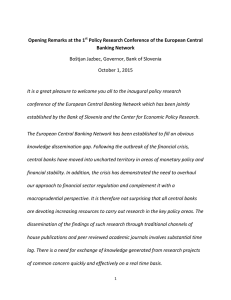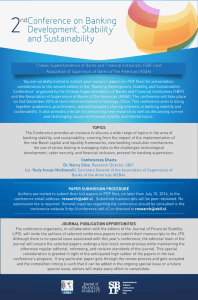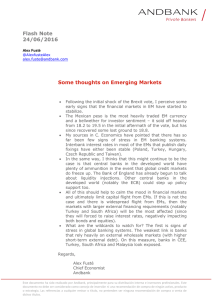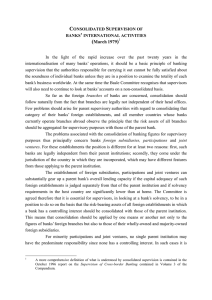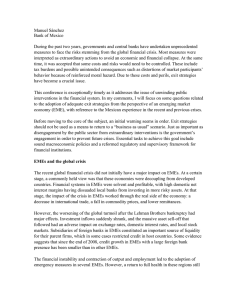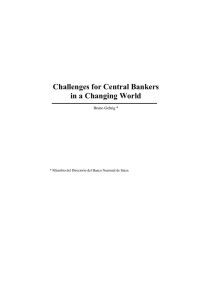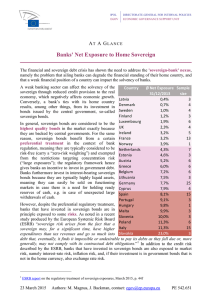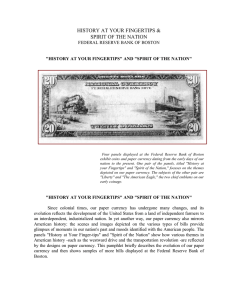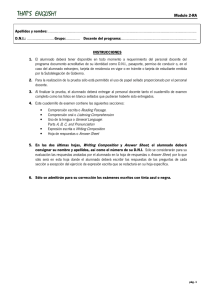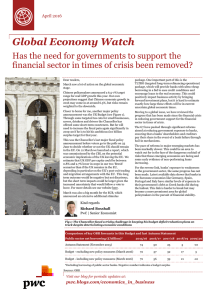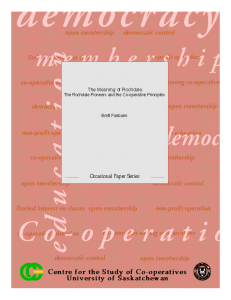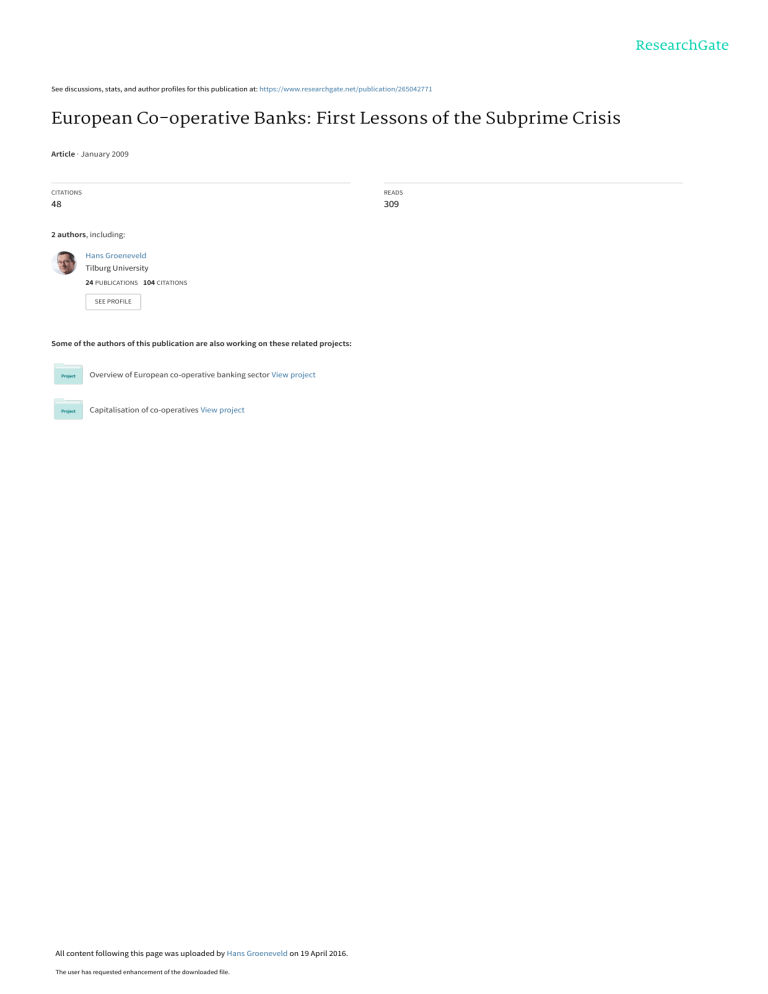
See discussions, stats, and author profiles for this publication at: https://www.researchgate.net/publication/265042771 European Co-operative Banks: First Lessons of the Subprime Crisis Article · January 2009 CITATIONS READS 48 309 2 authors, including: Hans Groeneveld Tilburg University 24 PUBLICATIONS 104 CITATIONS SEE PROFILE Some of the authors of this publication are also working on these related projects: Overview of European co-operative banking sector View project Capitalisation of co-operatives View project All content following this page was uploaded by Hans Groeneveld on 19 April 2016. The user has requested enhancement of the downloaded file. European co-operative banks: first lessons of the subprime crisis 1 European co-operative banks: First lessons of the subprime crisis Hans Groeneveld and Bouke de Vries 1 Abstract On the basis of qualitative and analytical insights, we formulate a number of hypotheses on the impact of the credit crisis on co-operative banks compared to commercial banks, which are subsequently tested. We conclude that co-operative banks should be able to demonstrate their ‘impact presence’ in financially and economically turbulent times in particular. Owing to their characteristics, structure and financial solidity they can be expected, for instance, to be able to back their customers for longer periods. This would be the result of steering a steady long-term course, which would be reflected in stable profit growth, relatively limited write-downs, low provisions and low losses, a high rating, fewer significant credit risks and a strong capitalisation vis-à-vis commercial banks over a long number of years. Tentative comparisons with commercial banks on the basis of key financial figures and simple measures of banking stability indicate a beneficial influence of co-operative banks on the stability of national financial systems. Before the US asset price bubble burst, co-operative banks did actually have better Tier 1 ratios, more stable profit growth and a more solid balance sheet structure. Their operations, measured in terms of the cost/income ratio, became more efficient in the years before the crisis. At the end of 2009, firmer conclusions will be possible on the position of cooperative banks in the recent financial crisis. JEL-codes: G21, L25, P13 1 Groeneveld and De Vries work at Rabobank Nederland. The views expressed in this article are personal and do not necessarily reflect those of Rabobank Nederland. The authors are very grateful to Willem Pieter de Groen for collecting and preparing the data (De Groen, 2009). This article was completed in June 2009. Correspondence to: [email protected]. European co-operative banks: first lessons of the subprime crisis 1 2 Introduction At the time of writing, the credit crisis is still far from over. While a systemic crisis has been averted by draconic measures of national governments and central banks, the future is uncertain. Despite extensive interest rate cuts, liquidity injections, government support and nationalisations the financial markets are still not fully stable. At the same time, the full extent of the real consequences of the credit crisis for the European economies is becoming increasingly clear. Recent figures show that the global economy will experience a deep recession in 2009 and perhaps also 2010. The financial crisis and the economic downturn give rise to a number of interesting questions concerning European co-operative banks. How have they fared so far? How much losses have they suffered and how much capital did they write off? Has their presence exerted a stabilising influence on the respective national financial systems? Obviously, it is still too early for clear, final answers to such questions. But we can relate these issues in qualitative terms to the features and business models of cooperative banks. By doing so, this article provides a first analytical impression and survey of the consequences of the crisis for co-operative banks and their influence on the financial systems in which they operate. Secondly, the basic position of co-operative banks in the future global financial order is outlined. 2 In light of this central question, we will first briefly describe the emergence as well as the bursting of the bubble in the US housing market, and also sketch the outlines of the new global financial system. This is followed, in section 3, by a description of the basic characteristics of co-operative banks in Europe: what are their core values and their brand values? These values offer insights into the approach and strategy pursued by co-operative banks before, during and after the credit crisis. On the basis of qualitative and analytical insights, we formulate a number of hypotheses on the impact of the credit crisis on co-operative banks compared to commercial banks. In section 4, we test these hypotheses quantitatively. The article ends with conclusions and observations. 2 The financial system before, during and after the financial crisis 3 The emergence of the bubble The roots of the most recent credit crisis lie in the United States. Initially, five key factors activated a self-reinforcing mechanism in the financial system (see diagram 1). This took place against a macroeconomic background of extensive worldwide imbalances in balances of payments, with the US developing into a major debtor. Low interest rates stimulated lending and raised households’ lending 2 We are venturing into largely unexplored territory here. For instance, the basic principles and implications of the co-operative model rarely feature in the recent academic literature (see Kalmi, 2007). Recent studies include those by the IMF (2007) and Oliver Wyman (2008). European co-operative banks: first lessons of the subprime crisis 3 capacity. This was boosted by strong economic growth and rising incomes. US house prices increased sharply, and although this decreased the affordability of houses, banks were prepared to provide further credit. This was based on expected continued rises in house prices. At the same time, lending criteria for mortgage loans were eased and more risky mortgage products were introduced. This set of circumstances gave rise to speculation in the US housing market and drove prices up further. Banks were able to continue to finance the accelerating credit growth by partly securitising mortgages immediately, which was stimulated by the prevailing international framework for banking supervision (basically, Basel I). Securitisation generated liquidity for banks and mitigated the pressure of lending on solvency. Securitisation enabled banks to free up a relatively substantial amount of capital to increase the provision of mortgages further. Owing to the increased risk tolerance and the search for yield among many market participants, the mortgage packages, despite their diminishing quality and increased risks, were in great demand for a long time among investors and banks worldwide. This was partly due to the fact that rating agencies – in hindsight, sometimes wrongly – gave high ratings to certain securitised products backed by mortgages. Investment banks played a major part in issuing the mortgage packages and also fed this ‘hunger for securitisation’, as it was a highly lucrative business. US supervisors and rating agencies insufficiently recognised the growing discrepancy between the actual and the underlying value of these financial products. This gave rise to a self-reinforcing process, nourished by over-optimism, insufficient pricing of risk and a search for yield in times of low interest rates. In the run-up to the financial crisis, the risks associated with financial transactions were collectively underpriced worldwide. 3 This is described in detail in Groeneveld (2008). European co-operative banks: first lessons of the subprime crisis 4 Diagram 1 Five causes of the credit crisis and systemic risks for the global financial sector Causes 1. Loose monetary policy, particularly in US - 2. New products, particularly nonstandard mortgages Financial innovations - 5. Income growth Wealth growth Low unemployment Easing of lending terms - 4. Cheap money: low interest rates Favourable economic conditions - 3. Consequences Special purpose vehicles - Credit default swaps Inadequate supervision - - Enormous rise in house prices Enormous lending volume Enormous underestimation of risk Enormous collective over-optimism Questionable role of rating agencies Supervisory framework provides incentive for lending and securitisations The bubble bursts This process of continually rising asset prices was abruptly ended by monetary tightening of the Federal Reserve Bank, which produced the now well-known chain reactions in the financial and economic systems. It started with increasing payment difficulties for households that led to foreclosure sales, which put pressure on house prices. A negative spiral of falling house prices, foreclosures, declining consumer and producer confidence, increasing defaults on credits, write-downs of credit portfolios in the US, worldwide losses and capital shortages at (investment) banks, a stagnating interbank money market and a complete loss of confidence in the financial system ensued (Bordo, 2008). Despite major liquidity support operations and enormous interest rate cuts by central banks and capital injections by governments around and after mid-2007, several banks have failed or had to be bailed out by take-overs or nationalisations all over the world. Box 1 When did the credit crisis start? It is difficult to pinpoint a starting date for the credit crisis: it was (and is) a chain of events in which one shock in the global financial system follows another. The chart below shows that credit spreads for high-risk European companies jumped around July 2007, according to the iTraxx CrossOver 5Y. 4 Liquidity in the financial system dried up rapidly and many market parties suddenly became aware of the deeply negative effects of the extremely exuberant and risky US credit growth. The beginning of the crisis can accordingly be set at mid-2007. A number of dramatic events followed and led to a steep 4 The iTraxx Crossover 5Y index is based on a basket of (credit default spreads) for European companies with a rating below investment grade. The spreads mirror differences with the five-year European swap interest rate. European co-operative banks: first lessons of the subprime crisis 5 rise in credit spreads, such as the nationalisation of Fannie May and Freddie Mac, the largest mortgage lenders in the US. The failure of Lehman Brothers in September 2008 was seen as a turning point: no one had expected that a government would actually let a bank of that size fail. The global impact of this event was enormous, confidence crumbled, share prices plummeted and global economic growth slowed. Consequently, risk spreads are likely to remain systematically higher than before the crisis. Chart 1 Credit spreads for high-risk corporate bonds 1350 1350 1150 1150 950 950 750 750 550 550 350 350 150 150 apr-07 jul-07 okt-07 jan-08 apr-08 jul-08 okt-08 jan-09 apr-09 Source: Bloomberg and Rabobank. The financial crisis also has far-reaching consequences for the real economies. Their weakened capital positions have made many banks appreciably more reticent in providing credits and loans to the private sector. The credit criteria for businesses and households have been tightened worldwide (see chart 2). European co-operative banks: first lessons of the subprime crisis Chart 2 6 Global tightening of lending criteria 90 90 60 60 30 30 Source: Bloomberg. This relates to credit conditions for businesses. Note: net percentage of lenders that have tightened credit terms for companies 0 0 -30 -30 VS Europa At the same time, the recession is causing a sharp fall in the propensity to invest and steeply falling consumer spending. Consumer and producer confidence in Europe has fallen dramatically, as has the demand for consumer durables. The ‘blame’ for the current sharp economic downturn is often attributed to the malfunctioning of the global financial system, and in particular to the ‘greed’ of bankers. Accusing fingers are also pointed at failing (mainly but not only American) supervisors. Anyway, the enormous scope of the problems necessitates a far-reaching reform of the global financial system. Outlines of a new global system The crisis has revealed various shortcomings of the financial system and its supervision. The main characteristics of the financial system are likely to change drastically as a consequence. We have pinpointed five major changes on which governments and politics are likely to insist in the near future: a greater focus on integrity and ethics, a healthy risk attitude, the application of a longer term perspective, more transparency and last but not least a greater customer focus. Of course, the financial sector has also performed a critical self assessment and is taking initiatives to improve its ethics, risk perception and risk attitudes. Accordingly, proposals have been put forward for an adequate structure of executive and employee remuneration in the financial system. 5 Overall, we expect that greater emphasis will be placed on people and their motives in taking financial decisions, as well as on the social role of banks. Integrity and ethics are central again and the shortterm perspective with an exclusive focus on material gains will be much less visible than in the recent past. Until recently, as stated above, subprime mortgages were sold and securitised, which involved high risks that few identified. It is clear now how short-sighted this was. 5 The Institute of International Finance (2008) advised on the payments structure at the start of 2008. The Advisory Committee on the Banks’ Future of the Dutch Banking Association (De Nederlandse Vereniging van European co-operative banks: first lessons of the subprime crisis 7 Both banks, institutional investors and businesses and private individuals must not (any longer) behave like lemmings disregarding the risks of complex financial instruments. In the context of consumer protection, we also expect a number of dodgy complex and non-transparent financial products to be banned that have been developed in the past few years in the financial sector (although partly on demand by the non-financial sector). The likely outcome will be: ‘the return to retail banking’ in the banking sector. Attracting savings to finance loans will become more important than wholesale and investment banking activities, that were major sources of all problems. All in all, we hope that the four aspects referred to here will contribute to a recovery of confidence in the financial system, which will in turn support financial stability. 3 Co-operative banks and the financial crisis: The theory In the global financial system, integrity and ethics will play a more important role at financial institutions than in the past. Traditionally, the financial sector thrives on trust. At the same time, we expect the strong focus on short-term gains and materialism to decrease. In a sense, the ‘new’ characteristics of the global financial system have been part of co-operative banks’ DNA from the start. Certainly, co-operative banks themselves take that view. In the words of the European Association of Co-operative Banks (EACB, 2005): “The primary mission of co-operative banks is to promote the economic interest of their members, who are their customers. Co-operative banks strive to do so by offering quality products and services at attractive prices from the perspective of what is good for the customer. They have an impact presence on the conditions of products in the whole banking market and support the economic and social integration of individuals” This concise formulation embodies the roots of co-operative banking. The customer is at the core of their operations and at a local level, members have a say in the local member bank’s policy, for instance on the branch location, opening hours and services. An interesting element in the passage above is the comment: co-operative banks have an ‘impact presence’. That is hard to demonstrate empirically, as it really only manifests itself on the entry or exit of a large co-operative bank. Through their presence, they exert an influence on the conditions of products throughout the entire banking market. Their stable income and high capitalisation are often said to make a positive contribution to the stability of national financial systems. The present credit crisis offers an ideal opportunity to test such claims. Interesting hypotheses on the conduct and the relative financial position of co-operative banks in Banken) has released the report “Towards restoring Confidence” in April 2009. European co-operative banks: first lessons of the subprime crisis 8 respect of the credit crisis can be derived from the corporate governance structure and the core values and brand values of co-operative banks (see Ferri, 2008). Firstly, owing to their long-term focus on customer value and members’ influence, co-operative banks do not aim at short-term profit maximisation. Robust profit growth is also important for co-operative banks to safeguard their continuity and continuing development. Healthy profitability is an important necessary condition, but not an goal in itself. 6 This means that co-operative banks can in challenging times, including the present credit crisis, stay longer behind their customers than their listed rivals. Listed banks tend to pursue profit maximisation for their shareholders as a strategic priority instead and will therefore perhaps more readily ration lending or raise interest rates for loans. In addition, in line with their origins, co-operative banks operate mainly in local retail markets, which should translate into stronger balance sheets and lower (credit) risks than for other private banks. Their local presence gives co-operative banks easier access to qualitatively good (i.e. stable) sources of funding in the form of (local) savings and deposits. Consequently, the balance sheet ratios on the liabilities side are often more solid than at many private banks. In addition, co-operative banks are literally and figuratively close to their customers and know those customers well through participation in numerous social networks. For the co-operative banking model centres above all on ‘relationship banking’. The well known academic issue of asymmetrical information between the bank and the customer when providing loans may be less pronounced in a co-operative banking system. With their strong local ties and networks, co-operative banks are in theory better equipped to assess the creditworthiness and risks of customers at a local level. The danger of moral hazard and adverse selection would consequently be more limited. If that is true, it can be assumed that – alongside the focus on customer value – this differentiator will be reflected, particularly in unfavourable times, in higher lending to or a longer average life of corporate customers. On the basis of the above, co-operative banks are expected to have invested less in and/or funded fewer complex, structured financial products than other banks and also to have sold much less of these products to their members/customers. Likewise, they are expected to have been more resilient regarding the use of securitisation, for which only premium grade mortgages would have been eligible in that case. But despite their different orientation, several co-operative banks have also suffered substantial losses. This shows that banks have, in one way or another, been unable to evade the effects of grave deficiencies in the financial system. It also demonstrates the close ties between all banks in a world with free international capital flows. 6 Co-operative banks do not distribute profit but add it to reserves, which is the main reason for their strong capitalisation. Profit is necessary to finance growth and provides a buffer for inclement times. European co-operative banks: first lessons of the subprime crisis 9 In sum, co-operative banks should be able to demonstrate their ‘impact presence’ in financially and economically turbulent times in particular. Owing to their characteristics, structure and financial solidity they can be expected, for instance, to be able to back their customers for longer periods. This would be the result of steering a steady long-term course, which would be reflected in stable profit growth, relatively limited write-offs, low provisions and low losses, a high rating, fewer significant credit risks and a strong capitalisation vis-à-vis commercial banks over a long number of years. Following that line of reasoning, the financial system could well be more stable in countries with a large co-operative banking sector than in countries where co-operative banks do not play a significant role. This would be related not only to a higher degree of capitalisation and a lower risk profile, but also to the existence of collective guarantee schemes to prevent the failure of individual co-operative banks. The next subsection will seek to test these hypotheses empirically. 4 Co-operative banks and the financial crisis: The practice Hypotheses can be derived from the business models and characteristics of co-operative banking models on the expected behaviour and the consequences of the presence of co-operative banks in times of financial distress, and therefore also in the current credit crisis. But it is extremely hard to substantiate these hypotheses empirically, particularly due to the scarcity of adequate and consistent data (see also Ferri, 2008). Nonetheless, that is what we will endeavour to do in this section. We will consider the question of how co-operative banks have weathered the credit crisis so far compared to private banks. What is, in view of the structure and market position described above, the impact of the credit crisis on the co-operative banks? We will be looking at the following, in this order: financial performance, actual losses, credit defaults swaps and what is known as the Z scores of co-operative banks. In doing so, we will also consider the influence of co-operative banks on the stability of national financial systems. 4.1 Financial performance of co-operative and commercial banks 7 One of the main findings of the preceding descriptive subsections was that co-operative banks are basically ‘different’ from commercial, or listed banks. This influences their conduct before, during and after the credit crisis. Below we examine whether these differentiating characteristics are reflected in their financial performance and/or key figures. Four important, interdependent indicators are reviewed: a. Tier 1 ratio b. Rating c. Profitability 7 The performance of the co-operative is not merely restricted to its financial performance or favourable pricing for customers. Performance is also reflected in the degree of customer satisfaction, in the extent banks act in customers’ interest, in the access offered to networks and knowledge of the bank, in the stability/duration of relationships, in the way banks deal with the environment/sustainability, in the degree of transparency et cetera European co-operative banks: first lessons of the subprime crisis 10 d. Efficiency (expenses/income ratio) a. Tier 1 ratios Chart 3 shows the Tier 1 ratio for several co-operative banks at year-end 2007, compared to the minimum capital requirement of 8% set by the market. 8 This ratio reflects the amount of equity compared to the risk-weighted assets of a bank. It may be concluded that co-operative banks maintain a comparatively high level of capital. 9 There are a number of explanations for this (see also Oliver Wyman, 2008). Firstly, the high capitalisation is connected with the strong focus of co-operative banks on retail operations. In view of the causes of the financial turbulences, it is strange but true that less stringent capital requirements applied to investment banking until recently than to retail banking. Secondly, co-operative banks add a major portion of their profits to the reserves year after year, and that is above all why they were able to become so large. 10 Thirdly, solid capitalisation is simply necessary for co-operative banks with a view to continuity. For in times of need co-operative banks are less readily able to raise their reserves, as they cannot issue shares. 11 (not necessarily in that order). It is virtually impossible to quantify the latter elements of ‘performance’. Tier 1 ratios under Basel 2. The statutory requirement is 4% but in practice the market demands 8%. This last percentage is included here. 9 The IMF (2007) claims that members have a reduced incentive to stimulate an optimum use of the high capital base, because they do not have a direct claim to the capital (it is ‘capital in dead hands’). This could possibly give rise to a risk of opportunistic investments by the executives of the bank. In this connection IMF researcher Fonteyne emphasises the importance of good governance and transparency for co-operative banks. This theoretical argument must be seen in the correct perspective however, as the influence of members at a local level passes to the central executive institutions with little dilution and these members can exert a major influence on the day-to-day decisions taken by the most senior management. 10 In the past, co-operative banks were sometimes criticised that their retained profits could be used more productively for the economy (see Oliver Wyman, 2008). This criticism is less frequently heard nowadays. 11 To increase capital flexibility, some co-operative banks created various options in the past to strengthen their capital base. The French Crédit Agricole took a far reaching step in listing over 45 per cent of its country organisation on the stock exchange market. Rabobank has introduced members’certificates, trust preferred securities (tps’s) and capital securities. 8 European co-operative banks: first lessons of the subprime crisis Chart 3 11 Tier 1 ratio Raiffeisen (CH) Rabobank (NL) Pohjola Group (Fin) C rédit Mutuel (FR) Banques Populaires (FR) C rédit Agricole (FR) RZB (AT) DZ Bank (DE) Minimal capital reserve 4 6 2008 8 10 12 14 2007 Source: Rabobank calculations. Chart 3 shows that the Tier 1 ratios of most co-operative banks in 2007 and 2008 were comfortably higher than the market’s minimum requirement of 8%. In the course of 2008, the Tier 1 ratios of many banks have deteriorated worldwide. Several banks have had to attract extra capital. This chart only illustrates the fact that co-operative banks entered the crisis with a strong capital base and subsequently strengthened their capital position in 2008. The notion that West-European co-operative banks, owing to their strong capital reserves and stable income in fact contribute to the stability of the banking system is increasingly supported by empirical studies. The researchers Hesse and Čihák (2007) of the IMF conclude that the strong capitalisation and the stable income of co-operative banks more than offset the adverse influence of lower profitability on their stability. Overall, in their view, financial co-operatives therefore contribute to the stability of the financial sector. b. Ratings Undoubtedly, rating agencies played a questionable role in the hey days of securitisation. Nevertheless, their ratings for banks or other businesses are more reliable than those for securitised US ‘mortgage packages’ and other derivative financial products such as ‘Structured Investment Vehicles’. The banks’ ratings reflect the financial health of the entire business and are not constructed at the request of banks. This contrasts with the ratings of the financial products mentioned above, which were requested by the issuer. And the pronounced incentive to give high ratings to these products was actually one of origins of the credit crisis. Table 1 Credit ratings of a number of co-operative and commercial banks, April 2009 Bank Type Standard & Poor’s Moody’s Fitch European co-operative banks: first lessons of the subprime crisis 12 France Banques Populaires BNP Paribas Crédit Agricole Crédit Mutuel Société Générale co-operative commercial co-operative co-operative commercial A+ AA AAA+ AA- Aa3 Aa1 Aa1 Aa3 Aa2 A+ AA AAAAAA- Germany DZ Bank Commerzbank Deutsche Bank co-operative commercial commercial A+ A A+ Aa3 Aa3 Aa1 A+ A AA- Finland Pohjola Group Nordea Bank Finland co-operative commercial AAAA- Aa1 Aa1 AAAA- Netherlands Rabobank Fortis Bank SA/NV ING Groep SNS REAAL co-operative commercial commercial commercial AAA A A+ A- Aaa A1 A1 Baa1 AA+ A+ A+ BBB+ Austria RZB Erste Group Bank co-operative commercial A A Aa2 Aa3 n.b. A Source: Rating agencies Fitch, Moody’s and Standard & Poor’s. Note: The rating shown for Crédit Agricole, Crédit Mutuel, DZ BANK and RZB is that of the central bank. There is no consolidated rating for all individual local member banks. The ratings awarded by Fitch, Moody’s and Standard & Poor’s for co-operative banks are stable and the financial solidity of these banks is still rated as ‘good’. Major elements in the rating are: the risk profile, capital buffer, stability of income flows, market shares, strategy and diversification of the activities. At the end of 2008 the rating agencies expected the operating results and the balance sheets of the co-operative banks to remain at a satisfactory level. As a rule, co-operative banks have strong ratings, as shown below. c. Profitability The qualitative insights feed the expectation that co-operative banks have below-average profitability, as they target customer value maximisation instead of profit maximisation. Profit is a key enabler, without which the co-operative cannot grow, cannot invest sufficiently. This would provoke members to cancel their membership because its added value would be reduced substantially. Profitability is usually assessed in terms of return on assets and return on equity. Own calculations based on a sample of 45 banks located in Western Europe shows that the return on assets and return on equity at co-operative banks are indeed lower than for commercial banks. European co-operative banks: first lessons of the subprime crisis 13 The lower return on equity is caused by the lower leverage resulting from a higher core capital ratio for the co-operative banks. Table 2 Average financial performance of banks, 2002-2007 (sample) Co-operative banks (N=9/O=53) Commercial banks (N=36/O=159) Percentage (standard deviation) Percentage (standard deviation) ROE 9.3 (4.5) 13.4 (8.5) ROA 0.4 (0.2) 0.5 (0.3) Core capital ratio 4.7 (1.4) 3.6 (1.4) Tier 1 ratio 9.2 (1.4) 8.4 (1.4) Cost/income ratio 62 (6.7) 61 (13.3) Source: Rabobank calculations (2008) based on annual reports. Figures are based on 45 large banks established in Western Europe. N= number of banks. O = number of observations during 2002-2007. d. Efficiency (cost/income ratio) Some claim that the absence of a profit objective, or a lower profit requirement, deprives cooperative banks of incentives to operate efficiently. On the income side, this would mean that they set a suboptimal price and that efficiently operating competitors realise a concealed ‘excess return’, i.e. profit on top of the co-operative price. On the cost side, the focus on customer value is said to provide an excuse for looser cost control and not operating efficiently (Van Diepenbeek, 2007). Benchmarking of expenses and income against the standards in the banking sector is essential in order to examine these aspects (see Van Diepenbeek, 2007). Studies carried out by the rating agency Moody’s (2002), the IMF (2007) and Oliver Wyman (2008) show that on average there is little difference between the efficiency of co-operative banks and commercial banks in Europe. In some countries, the co-operative banks in fact operate more efficiently, particularly in Western Europe. Our own calculations (table 2) bear this out. In addition, in the period from 2002-2007, the cooperative banks in all Western European countries, except France, operated more efficiently than commercial banks (see chart 4). European co-operative banks: first lessons of the subprime crisis 14 Chart 4 Cost/income ratio by country (2002-2007) Source: Rabobank & ECB (2008) Note: AT = Austria, FR = France, DE = Germany , NL = Netherlands. The cooperative banks in these countries were compared with the total group of 45 banks. 75% 70% 65% 60% 55% 50% 45% AT CH Cooperative banks DE FR NL Com m ercial banks Chart 5 Cost/income ratio of co-operative banks (2002-2007) Source: Rabobank (2008) Note: The calculations cover Germany, France, Austria, the Netherlands and Switzerland. The data for 2008 are not yet available because not all annual reports have been published yet. Changes in efficiency are also important. The expenses/income ratio of the co-operative banks improved significantly on average between 2002 and 2006 (chart 5). To be able to continue offering an attractive quality at a fair price to members and customers, it is necessary to achieve at least the same efficiency improvements as competitors. 4.2 Co-operative banking sector and losses due to the credit crisis Co-operative banks are traditionally strong in retail banking, which is characterised by a stable income stream and comparatively good access to savings and deposits. Most co-operative banks had only a limited direct exposure on the market for ‘toxic mortgages’. In addition, income from wholesale banking was relatively limited for most co-operative banks, the smaller ones in particular. Losses on complex credit products as a result of the crisis and revenue losses from wholesale banking are therefore limited in relative terms. Nonetheless, the amounts involved are still considerable for the co- European co-operative banks: first lessons of the subprime crisis 15 operative banks as well, certainly for the large banks. In addition, the economic crisis following the credit crisis will hit co-operative banks hard, as it will all other banks. Moreover, the competitive conditions are fairly distorted by all government interventions and funding costs have risen for all banks, including banks not needing the state support. Unfortunately, large co-operative banks did suffer considerable losses on wholesale banking operations and structured products. These losses are shown in table 3 as a percentage of the balance sheet and of equity, up to the time of completion of this publication (May 2009). Naturally, writedowns in the co-operative banking sector were largest for the largest co-operative banks in Europe. Compared to the balance sheet totals and equity, the write-downs/losses at co-operative banks are substantial in a number of cases, but fortunately still bearable in relative terms. 12 These amounts call for an important qualification. The indirect effects of the credit crisis have not yet materialised, and could not be quantified at the time of writing. They include, for example, the drying up of the interbank markets, the substantial distrust and uncertainty between banks, government intervention in the banking sector as well as the sharp global recession with the concomitant increases in bankruptcies and business failures. Table 3 Write-downs and losses resulting from the credit crisis at a number of co-operative banks (from July 2007 to year-end 2008) Bank Write-downs and losses as % of equity Crédit Mutuel Rabobank Banque Populaire DZ Bank / BVR Crédit Agricole RZB 6 6 9 14 14 15 Write-downs and losses as % of balance sheet total 0.3 0.3 0.5 0.5 0.5 0.7 Source: Annual reports and press releases of the banks concerned. The calculations are based on equity and balance sheet totals at year-end 2008. 4.3 Credit default swaps of co-operative banks A credit default swap spread (CDS) is the price that is paid/asked (in basis points above the European swap interest rate) for insuring against the risk of a counterparty’s failure and provides an indication of the probability of such failure. Given the characteristics of co-operative banks, these spreads are expected to be lower for them than for commercial banks. As mentioned above, co-operative banks have guarantee systems that minimise the risk of failure of individual local member banks. Unfortunately, CDS spreads for appreciably long time spans are only available for three large co- 12 In a number of countries, the co-operative banks also received support as part of a support package for all banks (Crédit Agricole) or because of exceptional circumstances, in Eastern Europe for instance. The banks operating in that region have been hit hard by the collapse of the economy. European co-operative banks: first lessons of the subprime crisis 16 operative banks (Crédit Agricole, Rabobank and RZB). We have compared changes in these premiums with those of five large commercial banks: BNP Paribas, ING, HSBC, Santander and Société Generale (chart 6). These are medium-to-large banks with substantial retail operations and significant wholesale banking operations. In the period from 2003 to the beginning of 2005 the probability of default for the three co-operative banks was estimated to be only slightly lower than for this group of five banks. This difference in CDS spreads in fact even narrowed further up to the summer of 2007. Chart 6 Credit default swap-spreads 180 CDS Swap rate (basispunten) 160 140 120 100 80 60 40 20 0 01-01-2003 01-01-2004 01-01-2005 Coöperatieve banken 01-01-2006 01-01-2007 01-01-2008 Commerciële banken Source: Bloomberg It is also evident that the CDS premiums for banks rose in stages after the crisis broke out at the end of July 2007: in mid-August 2007 they fell in response to intervention by the Federal Reserve Bank and the European Central Bank, only to rise again subsequently. This pattern was repeated a number of times, as it became clear time and again that no end to the problems was yet in sight. Around the start of October 2008 spreads for all banks skyrocketed, but those for co-operative banks did so to a slightly smaller extent. 13 They subsequently fell somewhat again and the spreads for the three co-operative and five commercial banks are at about the same level. From 2008, the risk premium is influenced by the state aid given to banks. We’ll come back to this aspect later on. The CDS results are surprising. We would expect the risk of failure for co-operative banks engaging mainly in retail activities, with a strong capitalisation and with guarantee schemes, to be lower than for the group of banks with more investment banking activities and a greater international focus. The CDS 13 In these times in which trust in banks is fragile, the CDS value can turn into a ‘self fulfilling prophecy’. Weaker banks with a high CDS spread run into trouble, because the market sees that other parties are already European co-operative banks: first lessons of the subprime crisis 17 spreads for the co-operative banks would on that basis have to be significantly lower. We can only guess at sound explanations of why that is not the case. One explanation could be that the international activities of the three co-operative banks distort the outcome. Those international activities can involve greater risks than the domestic activities (see RZB in Eastern Europe). Finally, from October 2008 no difference is visible any more in terms of the CDS premium. This is certainly influenced by the state support and capital injections. Risk premiums for banks receiving support fall compared to those for banks that do not. The flatter difference in risk premium can also be viewed as an assessment by investors that everything and everyone has become vulnerable owing to the crisis. In brief: this measure is surrounded by many uncertainties and does not support the hypothesis that co-operative banks are safer. 4.4 Stability of co-operative banks: the Z scores An elegant and simple measure for assessing the stability of co-operative banks and their impact on the stability of financial systems is the Z score. The Z score is used to compare the financial stability of a bank with that of other banks. This subsection focuses on the insights offered by this score. The Z score is determined by three factors: the return on assets (ROA), equity versus assets ratio (E/A) and the stability of the return on total assets (σ(ROA)). The Z score indicates by how many standard deviations the return on assets has to change to cause the bank’s assets to fall below the value of its debts. The higher the Z value, the more stable the bank (Mercieca et al., 2007). The Z score is calculated as follows: The table below shows the components and Z scores of 45 large European banks with a balance sheet total in excess of € 50 billion. This concerns 36 commercial banks and 9 co-operative banks. 14 demanding a higher risk premium. The premium rises further and in the end the bank has to be bailed out. This is a fairly small selection of banks and the results should be seen as tentative. Moreover, the interpretation of the figures must be put in perspective: a higher or lower percentage in one country does not immediately mean that banks are less stable in that country. It shows that within one specific timeframe, the volatility of results was greater with regard to the balance sheet and equity. 14 European co-operative banks: first lessons of the subprime crisis 18 Table 4 Components of Z scores 2002 Commercial banks (N=36) Core capital ratio 3.82% ROA 0.32% St dev ROA 0.18% Z score 46 Co-operative banks (N=9) Core capital ratio 4.31% ROA 0.29% St dev ROA 0.10% Z score 55 2003 2004 2005 2006 2007 3.76% 0.45% 0.17% 46 3.49% 0.58% 0.17% 45 3.38% 0.57% 0.17% 45 3.37% 0.57% 0.17% 45 3.05% 0.46% 0.16% 41 4.38% 0.31% 0.10% 56 4.57% 0.41% 0.10% 59 4.33% 0.46% 0.10% 57 3.95% 0.47% 0.10% 54 4.01% 0.40% 0.10% 54 Source: De Groen (2008). Calculations based on annual reports. Note: 45 large European banks are included in the sample, all with a balance sheet total in excess of € 50 billion. The figures are weighted with respect to total assets. The standard deviation is calculated for the entire period 2002-2007. In the entire period, the Z scores of the group of co-operative banks are substantially higher than those of commercial banks in the sample. In addition, the Z scores of the last group declined since 2002 by five points from 46 to 41, while those of co-operative banks have remained at around the same level. According to this measure, and based on this sample and time series, co-operative banks are therefore more stable. In terms of the three components, the ratio of equity/total assets at co-operative banks is systematically higher. This supports the observation that co-operative banks maintain larger capital buffers, on average. By contrast, the average return on assets for the whole period is lower for co-operative banks. This partly reflects the primary focus on maximisation of customer value. The ROA of co-operative banks has been continually developing towards that of commercial banks in the past few years. A reason for this could be the aforementioned efficiency improvement in the co-operative banking sector. Finally, the volatility of returns is lower at co-operative banks, again in line with theoretical expectations. This can be largely explained by the relatively extensive retail operations of co-operative banks, which on the whole generate more stable profits. In sum, the lower profitability of the cooperative banks is more than matched by a higher equity/asset ratio and more stable returns on assets. A notable feature in the development of the three components is that the level of the equity/assets ratio (E/A) declined significantly at commercial banks in the run-up to the crisis, from 2006 to 2007. At the same time, this ratio only came down marginally at the co-operative banks in the sample. A possible reason is that total assets rose strongly at these commercial banks and that they only partly retained their profits according to the wishes of their shareholders. The co-operative banks entered the crisis European co-operative banks: first lessons of the subprime crisis 19 with larger buffers, which again calls for the qualification that in good times, high buffers are viewed as ‘non-productive’. It is therefore not by definition ‘good’ or ‘better’ to have a high buffer. In addition, returns on assets fell for all banks in the sample from 2006 to 2007. Table 5 presents the Z scores at a country level, for the same 45 banks. It should be noted that banking operations outside the home market are also included. The calculations reveal that the co-operative banking sector is also very stable at a country level. France is an exception to this. It is not quite clear why that is the case. Possibly, the acquisition of Crédit Lyonnais by Crédit Agricole in 2002 affected the data series or the large and partly listed Crédit Agricole actually more closely resembles a commercial than a co-operative bank. Belgium and the United Kingdom do not have co-operative banks of any significant size (any more). Table 5 Z scores of six European countries (2002-2007) Country Belgium Germany France Netherlands Austria United Kingdom Switzerland Commercial banks 33 25 115 40 15 34 13 Co-operative banks -80 41 108 82 -97 Total 33 33 62 57 48 34 34 Source: Calculations by Rabobank, based on annual reports Chart 7 Relationship between market share of co-operative banks and average Z score in 7 countries 70 Source: Own calculations on the basis of data from the European Central Bank and annual reports of 45 large banks with balance sheet totals of € 50 billion or more. Note: AT = Austria, BE = Belgium, CH = Switzerland, DE = Germany , FR = France, NL = Netherlands, UK = United Kingdom. FR 60 NL )e r o cs - 50 Z ( y ti li b at 40 S AT UK BE CH DE 30 20 - 10 20 30 40 Market share co-operatives (%) R² = 0.8406 Chart 7 above shows how the average Z scores of all banks in the country where they are established relative to the market share of co-operative banks. On the basis of the straight solid line, there appears European co-operative banks: first lessons of the subprime crisis 20 to be a positive relationship between the size of the co-operative banking sector and the average Z score of the banking sector in the home market. But further examination of the significance of this relationship is required. Box 2 Credit and deposit growht at European co-operative banks One of the hypotheses in section 3 is that co-operative banks – can – support their customers for a longer period than other banks owing to their long-term focus on customer value and good capitalisation. In this respect, it could be instructive to examine whether credit growth was higher at co-operative banks than at commercial banks. However, it is still too early to test this hypothesis empirically. The required data are not yet available, but should be at the end of 2009. On the liabilities side, the stability of co-operative banks can be reflected in turbulent periods in a rising deposit market share. In uncertain times, savers tend to select solid and stable banks. In the Netherlands, Rabobank was initially faced with a sharp rise in savings owing to turbulences at competitors as well as the switch from investing to saving on the part of private customers. When the state nationalised Fortis/ABN Amro and both ING and SNS received state support, the competitive environment for banks changed substantially. The existing uncertainty among the public with regard to the nationalised or supported banks abated to some extent but a return to normality is still a long way off. The results and figures of all European co-operative banks will be awaited with interest in the coming period. 5 Conclusions and observations It is too early to draw final conclusions for co-operative banks from the present financial crisis, as the storm could rise again and many relevant data only become available with significant delays. What can already be concluded however is that so far the European co-operative banks have weathered the credit crisis comparatively well. On theoretical and analytical grounds, their business models and characteristics have proved to be major stabilising factors in national financial systems. It should be emphasized that problems in the lending portfolio due to the economic crisis may become visible in 2009 and 2010. Moreover, at Crédit Agricole, DZ and RZB (international) wholesale activities may still cause negative surprises. Empirically, these claims can as yet only be substantiated in part. Tentative comparisons with commercial banks on the basis of key financial figures and simple measures of banking stability indicate a beneficial influence of co-operative banks on the stability of national financial systems. Before the US asset price bubble bursted, co-operative banks did actually have better Tier 1 ratios, more stable profit growth and a more solid balance sheet structure. Their operations, measured in terms of the cost/income ratio, became more efficient in the years before the crisis. At the end of 2009, firmer conclusions will be possible on the position of co-operative banks in the recent financial crisis. European co-operative banks: first lessons of the subprime crisis 21 The co-operative banks are experiencing the consequences of the credit crisis through various channels and this article has provided a number of examples of these. The situation is very serious for all banks and the kind of confidence in the financial system that appeared to be existing for many years is still far beyond the horizon at present. In addition, the reputation of banks is seriously damaged. The credit crisis has gravely discredited the banking profession and the entire sector has come to be seen in a bad light. Worldwide drops in asset prices are causing banks to write down investments and to be reserved with lending. The turbulences also lead to reduced possibilities for funding in wholesale markets and there is distrust in the interbank market. Funding costs are soaring. If there is one lesson to be learnt for co-operative banks, it is that they must continue to steer a steady course and remain close to their core values and to traditional banking. Literature shows that the largest losses arise as soon as co-operative banks stray beyond the traditional scope of their business. Co-operative banks can make themselves heard jointly and take the lead in setting up the new global financial system. Retail banking is making a genuine comeback owing to the credit crisis. A very different view is taken nowadays of banks’ risks and the importance of solid capitalisation – both aspects on which co-operative banks already scored better before the credit crisis broke out. But additional comparative studies are required to develop a better understanding of the performance and impact of co-operative banks compared to other banks in the present turbulent market conditions. The Center for Economic Policy Research, a think tank in Brussels, is currently studying this in depth at the request of the European Association of Co-operative Banks, and Rabobank will surely contribute to this line of research in the coming years too. References Bordo, M.D. (2008), ‘An Historical Perspective on the Crisis of 2007-2008’, working paper. Diepenbeek, W.J.J. van (2007): Co-operatives as a business organization, lessons from co-operative organization history, University of Maastricht. European Commission (2008), ‘Quarterly report on the euro area’, Vol. 7, No. 4, pp.13-14. EACB (2005), Co-operative banks in Europe: values and practices to promote development. Ferri, G. (2008),’Why Co-operative Banks are Particularly important at a Time of Credit Crunch’, mimeographed, University of Bari, Italy. Fonteyne, W. (2007), ‘Co-operative Banks in Europe – Policy issues’, IMF Working Paper. Groen, W.P. de (2009), ‘Do Co-operative Banks use their capital efficient?’, Master Thesis, Free University of Amsterdam. European co-operative banks: first lessons of the subprime crisis 22 Groeneveld, J.M. (2008), ‘More supervision, less financial crises?’, Bank- en Effectenbedrijf , November 2008, pp. 22-26 (in Dutch). Hesse, H. and Čihák, M. (2007), ‘Co-operative Banks and Financial Stability’, IMF Working Paper. Institute of International Finance (2008), Final Report of the IIF Committee on Market Best Practices: Principles of Conduct and Best Practice Recommendations’, July 2008. Kalmi, P (2007), The disappearance of co-operatives from economics textbooks, Cambridge Journal of Economics 2007, 31, pp. 625–47. Mercieca, S., Schaeck, K. And Wolfe S. (2007), Small European Banks: Benefits from Diversification?, Journal of Banking and Finance, 31, pp. 1975-98. Oliver Wyman (2008): Co-operative Bank: Customer Champion. Salvo, R. Di (May 2003), The Governance of Mutual and Co-operative Bank Systems in Europe, Co-operative Studies, Edizioni del Credito Cooperativo. View publication stats
